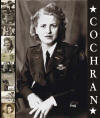|
JACQUELINE COCHRAN |
|
| Jacqueline Cochran was born, date uncertain, near the sawdust roads, cotton fields and small sawmill town of DeFuniak Springs in West Florida. She grew up in poverty, never owning a pair of shoes until she was nine. Her poverty and lack of education did not deter her. She went from being a barefoot girl, who stole chickens to help feed her family, to a decorated pilot who dined with Kings, Queens, Presidents, and Premiers. Young Jacqueline Cochran‘s first job was sweeping the floor and being a ’shampoo girl‘ in a beauty parlor, but the word ’can‘t’ was not in her vocabulary. She loved the sight of an airplane and believed that one day she would fly. She read, she listened, she asked questions and she never took ‘no’ for an answer. She believed in hard work, persistence and God--not necessarily in that order. In 1932 she earned her pilot‘s license, and in 1934 she entered her first air race. She became best friends with aviatrix Amelia Earhart, and by 1935 she had entered her first Bendix Air Race and owned a multi-million dollar cosmetics manufacturing company Jacqueline Cochran married Floyd Bostwick Odlum in Kingman, Arizona on May 11, 1936. In 1937 she won first place in the women’s division of Bendix and was the first woman to make a blind landing. She was awarded her first of 15 Clifford Burke Harmon International Trophies of the International League of Aviators as the outstanding woman flyer in the world. In 1938 she took first place in the Bendix Transcontinental and received the General Willie E. Mitchell Memorial Award as the person making the greatest contribution to aviation that year. In 1939, as Hitler‘s Nazi troops were marching across Europe, Jacqueline Cochran began to consider the possibility of America becoming involved and the possible future need for women to assist in flying America’s military aircraft. She conferred with the wife of President Roosevelt and, at her suggestion, approached General Hap Arnold with her plans for using women pilots, if they were ever needed. He rejected her plans. In April, 1940 Cochran breaks the 2,000 kilometer international speed record and the 100 kilometer national record. She wins the Minneapolis Air Classic Award as the outstanding woman pilot and receives her third of four trophies from the Women‘s NAA as the outstanding woman pilot for ’38, ‘39, ’40, and then ‘41. She established a woman’s national altitude record and broke the international open-class speed record for men and women. She won the McGough Memorial Award and the American Legion award. From 1941 to 1943 Jacqueline Cochran was the President of the 99s, an organization of women aviators founded in 1929. In 1941 General Hap Arnold asks her to go to England to study the program of the women pilots flying with the Royal Air Force. In June, 1941 she becomes the first woman to pilot a bomber across the North Atlantic. As the request of General Arnold and Britian‘s Chief/Air Mission, she organized a group of twenty-five American women pilots to fly for Great Britian. She accompanied them to England and remained to assist with plans for the newly arrived American 8th Air Force. By the Spring of 1942 there was a severe shortage of male pilots. General Hap Arnold asked Cochran to return to the United States and put her plans (to train women pilots to fly America’s military aircraft) into operation. On September 11, 1942 she is appointed Director of Woman‘s Flying Training for the United States. The first class of women pilots reported for training at the Houston Municipal Airport on November 11, 1942. Three months later, the program was moved to Avenger Field in Sweetwater, Texas The experimental flying training program was successful, and in July, 1943 Cochran is appointed to the General Staff of the U.S. Army Air Forces to direct all phases of the Women Airforce Service Pilots (WASP) program at 120 air bases all over America. On 20 December 1944 the WASP program was discontinued and the WASP disbanded. In 1945 Jacqueline Cochran received the U.S. Distinguished Service Medal, travels to the Far East and witnesses General Yamashita’s surrender in the Phillippines and was the first woman to enter Japan after WWII. After the war, Jacqueline Cochran continued to participate in air races and to establish new transcontinental and international records. In 1953 she became the first woman to exceed the sound barrier. (She still holds more international speed, distance and altitude records than any other pilot, male or female.) In 1971 Jacqueline Cochran was enshrined in the Aviation Hall of Fame in Dayton, Ohio-the first woman to be so honored. (additional accomplishments, titles, and honors .) On August 9, 1980 Jacqueline Cochran died at her home in Indio, California. Memorial services were held at the U.S. Air Force Academy, Colorado Springs, Colorado. Jacqueline Cochran went higher and faster into the frontiers of aviation than any woman before, breaking through the glass ceiling and the sound barrier--from rags to riches-blazing a trail for other heroic women to follow. She was truly ‘one of a kind’. What drove her? What made her special? There‘s no simple recipe for success but she did leave a message for the next generation: ’If you will open up your power plants of vitality and energy, clean up your spark plugs of ambition and desires, and pour in the fuel of work, you will be likely to go places and do things. back *written by WASP Deanie Parrish | © 2005 Wings Across America |
|

